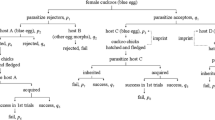Abstract
The Horsfield’s bronze-cuckoo (Chalcites basalis) egg closely matches the appearance of its host fairy-wren (Malurus spp.) eggs. Mimicry of host eggs by cuckoos is usually attributed to coevolution between cuckoos and hosts, with host discrimination against odd-looking eggs selecting for ever better mimicry by cuckoos. However, this process cannot explain Horsfield’s bronze-cuckoo egg mimicry because fairy-wren hosts rarely reject odd-looking eggs from their nest. An alternative hypothesis is that cuckoos have evolved egg mimicry to disguise their eggs from other cuckoos. Female cuckoos remove one egg from the nest during parasitism and would potentially benefit by selectively removing any cuckoo egg that has already been laid in the nest because otherwise, their egg will be evicted by the first nestling cuckoo along with the host clutch. We used painted, non-mimetic eggs to test whether cuckoos selectively remove odd-looking eggs during parasitism. We found that they were no more likely to remove a non-mimetic egg from a superb fairy-wren Malurus cyaneus clutch than would be expected by chance. Thus, our study does not support the cuckoo egg replacement hypothesis to explain mimicry of host eggs by cuckoos.
Similar content being viewed by others
References
Antonov A, Stokke BG, Moksnes A, Røskaft E (2006) Egg rejection in marsh warblers (Acrocephalus palustris) heavily parasitized by common cuckoos (Cuculus canorus). The Auk 123:419–430
Brooke M de L, Davies NB (1988) Egg mimicry by cuckoos Cuculus canorus in relation to discrimination by hosts. Nature 335:630–632
Brooker MG, Brooker LC (1989a) The comparative breeding behaviour of two sympatric cuckoos, Horsfield’s Bronze-Cuckoo Chrysococcyx basalis and the Shining Bronze-Cuckoo C. lucidus, in Western Australia: a new model for the evolution of egg morphology and host specificity in avian brood parasties. Ibis 131:528–547
Brooker MG, Brooker LC (1989b) Cuckoo hosts in Australia. Aust Zool Rev 2:1–67
Brooker MG, Brooker LC, Rowley I (1988) Egg deposition by the bronze-cuckoos Chrysococcyx basalis and Ch. lucidus. Emu 88:107–109
Brooker LC, Brooker MG, Brooker AMH (1990) An alternative population/genetics model for the evolution of egg mimesis and egg crypsis in cuckoos. J Theor Biol 146:123–143
Davies NB (1999) Cuckoos and cowbirds versus hosts: Co-evolutionary lag and equilibrium. Ostrich 70:71–79
Davies NB (2000) Cuckoos, Cowbirds and Other Cheats. T. & A. D. Poyser, London
Davies NB, Brooke M de L (1988) Cuckoos versus reed warblers: adaptations and counteradaptations. Anim Behav 36:262–284
Davies NB, Brooke M de L, Kacelnik A (1996) Recognition errors and probability of parasitism determine whether reed warblers should accept or reject mimetic cuckoo eggs. Proc R Soc Lond B 263:925–931
Edvardsen E, Moksnes A, Røskaft E, Øien IJ, Honza M (2001) Egg mimicry in cuckoos parasitising four sympatric species of Acrocephalus warblers. Condor 103:829–837
Grim T (2005) Mimicry vs. similarity: which resemblances between brood parasites and their hosts are mimetic and which are not? Biol J Linn Soc 84:69–78
Higuchi H (1998) Host use and egg color of Japanese cuckoos. In: Rothstein SI, Robinson SK (eds) Parasitic Birds and their Hosts: Studies in Coevolution. Oxford University Press, Oxford, pp 80–93
Honza M, Procházka B, Stokke BG, Moksnes A, Røskaft E, Capek M Jnr, Mrlik V (2004) Are blackcaps current winners in the evolutionary struggle against the Common Cuckoo? Journal of Ethology 22:175–180
Honza M, Voslajerová K, Moskát C (2007) Eviction behaviour of the common cuckoo Cuculus canorus chicks. J Avian Biol 38:385–389
Langmore NE, Hunt S, Kilner RM (2003) Escalation of a coevolutionary arms race through host rejection of brood parasitic young. Nature 422:157–160
Langmore NE, Kilner RM, Butchart SHM, Maurer G, Davies NB, Cockburn A, Macgregor N, Peters A, Magrath MJL, Dowling D (2005) The evolution of egg rejection by cuckoo hosts in Australia and Europe. Behavioral Ecology 16:686–692
Langmore NE, Adcock GJ, Kilner RM (2007) The spatial organization and mating system of Horsfield’s bronze-cuckoos Chalcites basalis. Animal Behaviour 74:403–412
Lawes MJ, Kirkman S (1996) Egg recognition and interspecific brood parasitism rates in Red Bishops (Aves: Ploceidae). Anim Behav 52:553–563
Rowley I (1965) The life history of the superb blue wren Malurus cyaneus. Emu 64:251–297
Stokke BG, Hafstad I, Rudolfsen G, Moksnes A, Møller AP, Røskaft E, Soler M (2008) Predictors of resistance to brood parasitism within and among reed warbler poulations. Behav Ecol 19:612–620
Zann RA (1996) The zebra finch: a synthesis of field and laboratory studies. Oxford University Press, Oxford
Acknowledgements
We thank S. Butchart, N. Davies, J. Gardner, S. Hunt, G. Maurer and A. Peters for invaluable help in the field and A. Cockburn for providing data on superb fairy-wren clutch abandonment rates in undisturbed nests. NEL was supported by an Australian Research Council Fellowship. RMK was supported by a Royal Society University Research Fellowship. We are grateful to Environment ACT and the Australian National Botanic Gardens for permission to work on the study sites. Experiments comply with the current laws of the country in which they were performed.
Author information
Authors and Affiliations
Corresponding author
Additional information
Communicated by M. Soler
Rights and permissions
About this article
Cite this article
Langmore, N.E., Kilner, R.M. Why do Horsfield’s bronze-cuckoo Chalcites basalis eggs mimic those of their hosts?. Behav Ecol Sociobiol 63, 1127–1131 (2009). https://doi.org/10.1007/s00265-009-0759-9
Received:
Revised:
Accepted:
Published:
Issue Date:
DOI: https://doi.org/10.1007/s00265-009-0759-9




